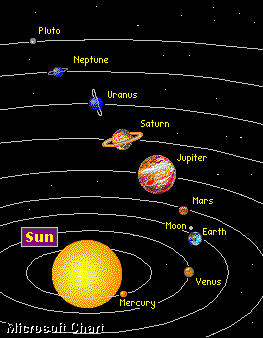 Solar system
Solar system Solar system
Solar systemOur Solar System is a stellar-planetary unit consisting of the Sun ; the nine planets and their satellites; the asteroids, comets, and meteoroids; and interplanetary dust and gas. The dimensions of this system are specified in terms of the mean distance from the Earth to the Sun, called the astronomical unit (AU). One AU is 150 million km. The most distant known planet, Pluto, has an orbit at 39.44 AU from the Sun. The boundary between the solar system and interstellar space - called the heliopause - is estimated to occur somewhere beyond 120 AU. The comets, however, achieve the greatest distance from the Sun; they have highly eccentric orbits ranging out to 50,000 AU or more.
Space physics is typically interested in the plasma environments found in the solar system, where in situ measurements can be performed. Especially the solar wind and interplanetary magnetic field , and planets with internal magnetic fields (and thus also magnetospheres ) and/or ionospheres are important. These are Mercury, Earth, Jupiter, Saturn, Uranus, and Neptune.
